Toe Implants
Toe Implants
Many patients with toe pain or Hallux Rigidus are looking for alternative treatment options to a Toe Fusion Procedure, also known as an Unfusion. The Toe HemiCAP® implant system is a toe replacement designed to preserve motion and allow patients to resume desired activity levels. This minimally invasive, metatarsal implant matches the shape and contour of each individual patients’ joint surface allowing for increased range of motion. A contoured cap replaces the area of damaged cartilage and protects the remaining (healthy) cartilage in the joint while removing minimal bone. Unlike synthetic implants such as Cartiva, traditional stemmed implants or toe fusion, the HemiCAP® is comprised of two separate components, a cap and screw that mate together via morse taper lock. One-piece synthetic or stemmed toe implants have been shown to loosen or slip, whereas the HemiCAP® screw system has been a stable construct with no reported loosening over the last 15 years. The idea behind the system is to prevent further damage to the joint while maintaining the patient’s natural motion. If you are unhappy with your fusion due to the stiffness and lack of motion in the joint, it is possible to have an unfusion. An unfusion is where the surgeon removes the fusion plate and replaces it with the ToeMotion Arthroplasty system. There are many factors for your surgeon to consider and evaluate before deciding if an unfusion is right for you.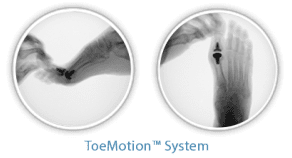
For patients with extensive damage on both sides of the joint, Arthrosurface® also provides a total toe implant called the ToeMotion®. This consists of the Toe DF HemiCAP® implant on the metatarsal side of the joint and a metal baseplate with plastic insert for the opposing (phalangeal) side of the toe joint. The Arthrosurface total toe is different than other replacements because it is implanted into the bone rather than on top, leaving natural bone to support the implant around its edges. This type of implant placement does not disturb surrounding tissue attachments which are needed to maintain stability and lift-off for walking. The Arthrosurface ToeMotion is also the only total toe replacement that is implanted with screws on both sides of the joint to provide rock-solid fixation.
For patients looking to maintain an active lifestyle, while you remain active and eliminate toe pain, receiving a toe fusion is not a viable or appealing option because the toe will never bend again. With the Arthrosurface Toe Implant Systems, patients now have a surgery option that is minimally invasive, stable and motion-preserving, allowing patients to retain their active lifestyles.
Toe Pain
Once cartilage is damaged, it cannot heal itself. The progressive deterioration of the joint can lead to a loss of cartilage and exposed bone. Because toe pain sensors are located in bone and not in cartilage, it is the exposed bone that results in a painful joint. 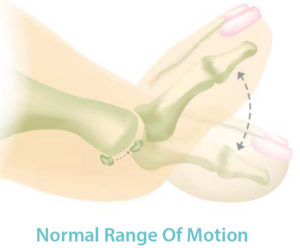
What Can Cause the Damage?
Many things could be the cause of your toe pain, including but not limited to:
- Injury
- Trauma
- Continued malalignment
- Disease process (i.e. inflammation)
- Footwear
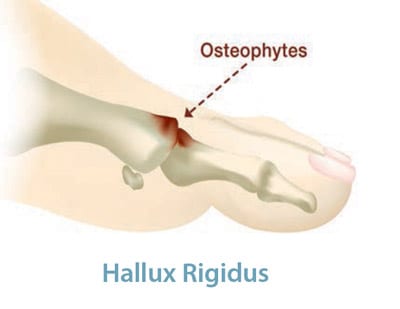
A small cartilage injury may become larger and lead to widespread cartilage loss or degenerative joint disease over time — eventually resulting in toe joint surgery. As the “wear and tear” on the toe (MTP) joint progresses, bone spurs (osteophytes) can form on top of the bones. These bone spurs are extremely painful and can limit the motion of the joint. With time, the spurs grow larger, the cartilage starts to wear away and the toe becomes stiff. In the big toe, this condition is called Hallux Limitus or Hallux Rigidus. A Hammertoe can be caused by the following:
- Arthritis
- Ill-fitting shoes
- Tightened ligaments or tendons in the foot.
- Pressure from a bunion (when your big toe points inward toward your second toe)
When the muscles in your toe fall out of balance, a hammertoe can form. Muscle imbalance puts a lot of pressure on the toe’s tendons and joint causing them to form the shape or a hammerhead. Hammertoe surgery is often required to fix the problem. Bunions: Bunions are most commonly the result of genetics. However, ill-fitting shoes also play a large part in the formation of bunions and the resulting toe joint pain. Women are more prone to developing bunions due to tight, high-heeled shoes.
An Arthrosurface joint restoration procedure is for someone who has been told by their doctor, orthopaedic surgeon or podiatrist that they have damaged cartilage and/or an arthritic joint. After trying non-operative treatments, such as orthotics, shoe modification, steroid injections, physiotherapy, pain and anti-inflammatory medications, the pain remains problematic and debilitating. Most likely, you have been told that your next option will require surgery which may limit your motion or your ability to wear certain types of shoes depending on the procedure. The Arthrosurface® Toe HemiCAP® systems are indicated for the treatment of patients with the following clinical conditions:
- Hallux rigidus
- Hallux limitus
- Hallux valgus
- Have an unstable, stiff and/or painful toe joint
- Have been diagnosed with Arthritic Toe Joints (arthritis)
- Aged 35 to 75 years old and want to regain your active lifestyle
- Do not want to lose the mobility of the joint
- Want to be able to bend your toe, reach up and kneel again
- Want to wear normal shoes such as high heels or boots
- You want to fix your toe problem now vs. waiting for your toe to undergo further damage
- You have been told by a surgeon that you will need a toe fusion
*Seek professional medical advice for specific personal care.
With the Arthrosurface® Systems, the surgeon only restores the damaged area of the joint, similar to the way a dentist fills in a cavity, leaving the rest of the structures in your joint intact. This way, your native anatomy is preserved. The exposed and painful bone is covered, while all the structures in your joint that help you move and function properly are left in place allowing you to return to your normal active lifestyle.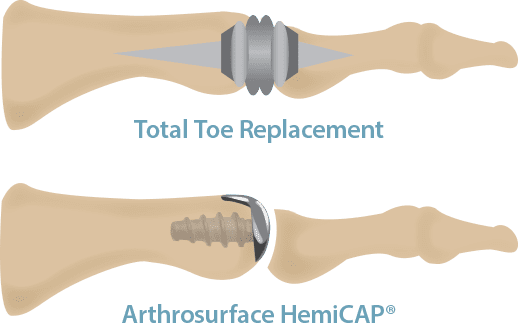

- It is custom matched and fit to a patient’s joint size and shape
- Significantly less cartilage and bone is removed than traditional joint replacements
- It is placed into the surface rather than on top, leaving the joint less surgically altered
- Joint motion and the native structures are preserved so no bridges are burned
The HemiCAP® implant was the first implant designed for the metatarsal side of the joint, which is where the arthritic changes begin. This side also tends to have more wear and tear as well as spurring. Other hemiarthroplasty devices replace the phalangeal side, which may still have remaining cartilage and fails to address the primary disease site, which is the metatarsal.
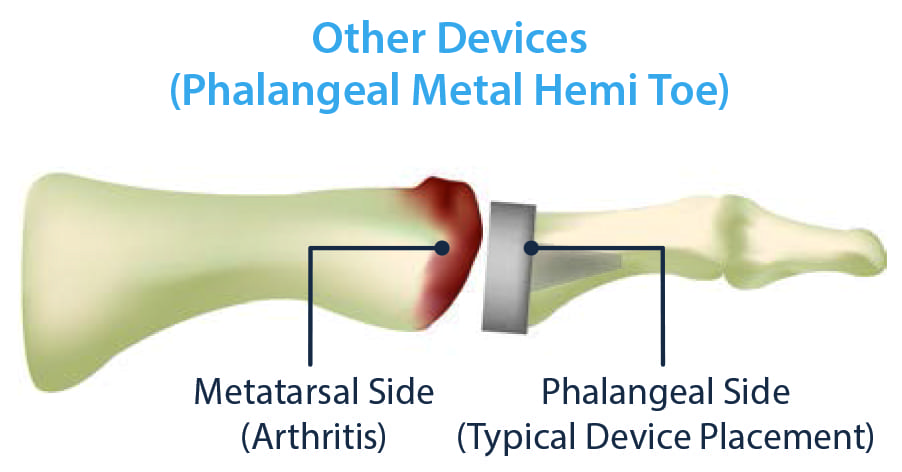
For many patients who have widespread arthritis with damage on both sides of the joint, the Arthrosurface ToeMotion™ system can also be a great option. The system restores both sides of the joint by implanting a HemiCAP® on the metatarsal side and a metal baseplate with plastic insert on the opposing side of the joint. Unlike standard total toe replacements or fusions, the ToeMotion™ system can restore a natural range of motion while alleviating or eliminating pain. 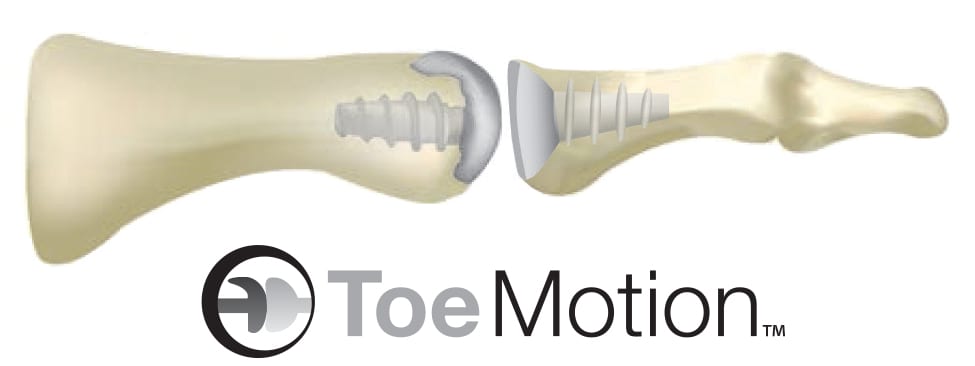
In multi-center studies, patients reported outstanding pain relief, rapid recovery times and significant range of motion improvements. The procedure may be performed on outpatient basis.  Every surgery has risks and your prospects for a safe and successful surgery must be evaluated with your surgeon. A successful joint restoration procedure may significantly improve your quality of life by reducing pain and restoring function. Many patients return to full activity after rehabilitation and go back to doing things that they had previously given up due to a painful joint. After the surgical repair of a joint, your surgeon will provide you with specific post-operative instructions which you need to follow carefully. Post-operative rehabilitation recommendations will vary depending on the invasiveness of your surgery and your individual recovery patterns. The immediate focus in all surgeries will be on swelling and pain management. In some cases you may wear a brace for a few weeks and will be prescribed exercises and activities to begin strengthening your muscles.
Every surgery has risks and your prospects for a safe and successful surgery must be evaluated with your surgeon. A successful joint restoration procedure may significantly improve your quality of life by reducing pain and restoring function. Many patients return to full activity after rehabilitation and go back to doing things that they had previously given up due to a painful joint. After the surgical repair of a joint, your surgeon will provide you with specific post-operative instructions which you need to follow carefully. Post-operative rehabilitation recommendations will vary depending on the invasiveness of your surgery and your individual recovery patterns. The immediate focus in all surgeries will be on swelling and pain management. In some cases you may wear a brace for a few weeks and will be prescribed exercises and activities to begin strengthening your muscles.  Here are a few helpful suggestions as you recover and rehabilitate from your toe surgery:
Here are a few helpful suggestions as you recover and rehabilitate from your toe surgery:
- Follow the recommendations of your surgeon and physical therapist.
- Keep a log to track your progress as you recover and increase activity.
- Ask for assistance from family and friends to help with chores and errands during your recovery.
- Walking aids such as crutches or a cane may reduce stress on your operated toe
- Eliminate possible tripping hazards in your home – wires, cables, rugs, etc.
- Return to any moderate or demanding activities should be guided by your tolerance for weight bearing.
We wish you good luck with your decision and your treatment
